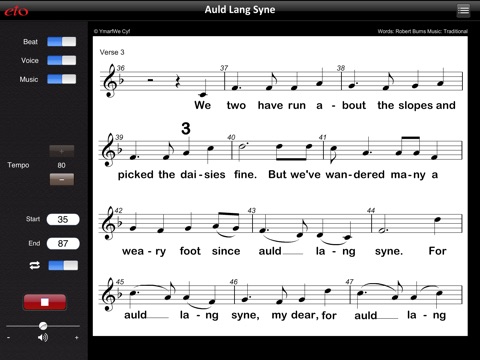
Auld Lang Syne - Learn to pronounce and sing Auld Lang Syne
eto Music Practice offers help to all those who might need help in singing and pronouncing the words of the global anthem Auld Lang Syne.
( 友谊地久天长 )
The words of all five verses and chorus are carefully spoken and then sung with correct pronunciation at slow tempi to a full band accompaniment.
By choosing a start bar and an end bar you can use the repeat facility and practise the complete song phrase by phrase, sentence by sentence or verse by verse at any of the speeds.
At an appropriate faster tempo we provide a sung guide vocal. This guide vocal can be used in order to learn the correct musical phrasing of the words. It too can be practised as described above.
Although loud enough to be properly heard, the vocal part is sung at a volume which allows you to sing along until you have enough confidence to switch off the vocal part. You can then enjoy singing with the band; on your own or with friends.
History
"Auld Lang Syne" is a Scots poem written by Robert Burns in 1788 and set to the tune of a traditional folk song. It is well known in many countries, especially in the English-speaking world, its traditional use being to bid farewell to the old year at the stroke of midnight. By extension, it is also sung at funerals, graduations and as a farewell or ending to other occasions.
The songs Scots title may be translated into English literally as "old long since", or more idiomatically, "long long ago", "days gone by" or "old times". Consequently "For auld lang syne", as it appears in the first line of the chorus, might be loosely translated as "for (the sake of) old times".
The phrase "Auld Lang Syne" is also used in similar poems by Robert Ayton (1570–1638), Allan Ramsay (1686–1757), and James Watson (1711) as well as older folk songs predating Burns.Matthew Fitt uses the phrase "In the days of auld lang syne" as the equivalent of "Once upon a time..." in his retelling of fairy tales in the Scots language.
Some of the lyrics were indeed "collected" rather than composed by the poet; the ballad "Old Long Syne" printed in 1711 by James Watson shows considerable similarity in the first verse and the chorus to Burns later poem and is almost certainly derived from the same "old song".
There is some doubt as to whether the melody used today is the same one Burns originally intended, but it is widely used in Scotland and in the rest of the world.
Singing the song on Hogmanay or New Years Eve very quickly became a Scots custom that soon spread to other parts of the British Isles. As Scots (not to mention English, Welsh and Irish people) emigrated around the world, they took the song with them.
埃托奥音乐练习提供帮助的所有谁可能在宣告全球国歌友谊地久天长的话需要帮助的。
所有五个诗句和合唱的话是认真谈过,正确的发音在慢拍子,以一个完整的乐队伴奏。
通过选择一个开始吧,结束吧,你可以使用重复设施,并在任何速度的练习曲完全由词组短语,一句一句诗或诗所。
在适当的快节奏,我们提供了一个唱声乐指导。本指南声乐可以为了学习的话正确的音乐表达方式使用。它也可以如上面描述的情况下实施。
虽然不够响亮,正确听到,人声部分,在演唱的体积,它允许你,直到你有足够的信心去关掉人声一起唱。然后,您可以享受与乐队唱歌;你自己或与朋友。
eto Music Practice



